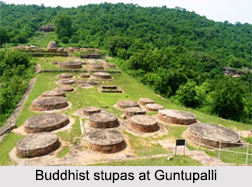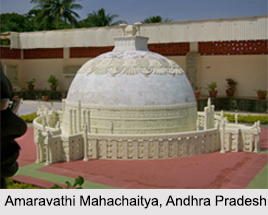 The southern Indian states house multiple Buddhist viharas and stupas, be it the Amaravathi Mahachaitya stupa and protected Buddhist monument complex at Bavikonda in Andhra Pradesh, or the Chudamani Vihara in Tamil Nadu and Namdroling Monastery of Tibetan Buddhism in Karnataka.
The southern Indian states house multiple Buddhist viharas and stupas, be it the Amaravathi Mahachaitya stupa and protected Buddhist monument complex at Bavikonda in Andhra Pradesh, or the Chudamani Vihara in Tamil Nadu and Namdroling Monastery of Tibetan Buddhism in Karnataka.
Guntupalli, Andhra Pradesh
The census town of Guntupalli in Krishna district of Andhra Pradesh is a relevant archaeological site of Buddhism, possessing small monasteries, ancient stone stupas and rock-cut temples from where Buddhist relics and monolithic remnants dating back to 2nd and 3rd centuries BC were found. A large monastery encompassing numerous cells wherein Buddhist monks resided was also unearthed. A stone stupa had been unearthed in late 19th century with rock and gold crystals excavated along inside a stone casket.
Amaravathi Mahachaitya, Andhra Pradesh
The Amaravathi Mahachaitya, popularly known as the great stupa at Amaravathi village, is a ruined Buddhist monument in Guntur district of Andhra Pradesh, under the protection of the Archaeological Survey of India (ASI). The campus includes the Mahachaitya itself along with the Archaeological Museum. The significant relics and sculptural representations from the site are today exhibited in a number of museums across India and abroad.
Bhattiprolu, Andhra Pradesh
Bhattiprolu in Guntur district of Andhra Pradesh is an important Buddhist site known for the Buddha Stupa, called "Vikramarka kota dibba", built between 3rd and 2nd century BC. Excavations in 1870 discovered three mounds and those in 1892 uncovered three inscribed stone relic caskets containing crystal caskets, relics of Buddha and jewels. Remains of the great stupa"s large pillared hall, a large group of ruined votive stupas with several images of Buddha, a stone receptacle containing copper vessel, which in turn contained a silver casket within which, a gold casket enclosing beads of bone and crystal were discovered.
Salihundam, Andhra Pradesh
Salihundam in Andhra Pradesh is a historically noted village for its Buddhist remnants that include numerous Buddhist stupas and a huge monastic complex. Excavations in the site have unveiled relic caskets, four stupas, a Chaityagriha, structural temples and numerous sculptures reflecting three phases of Buddhism - Theravada, Mahayana and Vajrayana, dating back to 2nd century BC to 12th century AD.
Kanaganahalli, Karnataka
Kanaganahalli village in Karnataka is another Buddhist archaeological site, excavations wherein have unearthed remains of an ancient Mahastupa, votive stupas and brick structures in the form of a Chaityagriha, images of Buddha, antiquities like lead coins and a sculptural representation of Mauryan king Ashoka, labeled "Rayo Asoka".
Chudamani Vihara, Tamil Nadu
Chudamani Vihara was a Buddhist monastery constructed in 1006 CE, in present Nagapattinam town of Tamil Nadu. The vihara had survived in dilapidated condition till 1867 and since 1856, about 350 Buddha bronzes had been found, tracing from 11th to 16th centuries.




